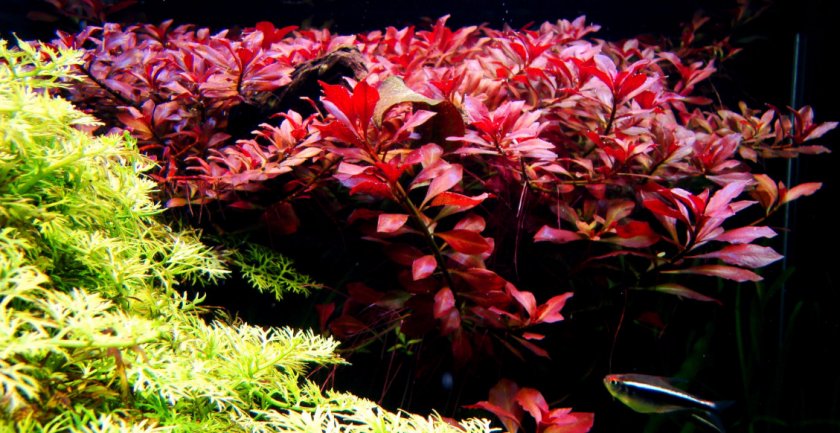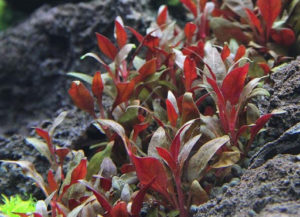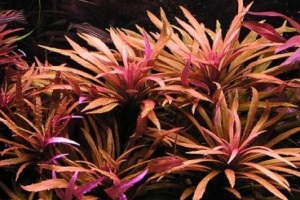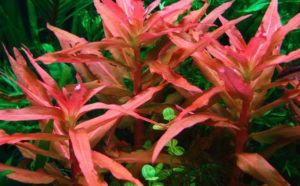Experienced aquarists, who have gotten a hand in combining all shades of green, inevitably face the problem of expanding the palette. Best red aquarium plants for beginners becomes an organic way out of emerald captivity. Plants of this shade look spectacular against the background of the malachite jungle.

- Aquarists often restrain their desire to enrich the color scheme of the underwater landscape. Even beginners know that there are certain difficulties with the maintenance of this group of plants.
- Special care and additional introduction of nutrients are 2 prerequisites for growing red-leaved plants. But, despite the difficulties, the result obtained justifies the effort expended.
Table of Contents
How do aquarium plants get red?
The color of plants depends on special chemical elements. These pigments not only determine the color but are also responsible for the life cycle of higher vegetation. Chlorophyll, for example, reflects green rays. Therefore, this element is green.
It is not surprising that it gives a green tint to all organs in which it is present. But it is not the only colorant. Flavonoids, classified as flavonones and flavones, are also responsible for the variety of colors.
They protect plant tissues from the harmful effects of ultraviolet radiation. This protective function is achieved through the absorption of light in the short wavelength range.
The higher the concentration of ultraviolet radiation in the light beam, the more flavonoids are synthesized. And with an increase in the content of these elements, the leaf plate becomes redder.
Since ultraviolet light does not penetrate into the aquatic environment of the aquarium, the theory with flavonoids does not work.
Firstly, the flux of ultraviolet radiation is blocked by a protective shell of fluorescent lamps.
Secondly, this kind of electromagnetic flow is absorbed by water. According to the results of recent research, the color red is in the area of responsibility for carotenoids.
Depending on the plant species, there are 2 main spheres of influence of orange, yellow, and red plant pigments:
- Shade-tolerant crops. For vallisneria, bolbitis or anubias, for example, they act as additional light-harvesting elements. They absorb rays in the part of the spectrum in which chlorophyll is not particularly strong. But due to the fact that the concentration of carotenoids in this range is negligible, there is no transformation from green to red.
- Light-loving species. This group includes aquarium cultures of all shades of red, from pale pink to purple and red-violet. The carotenoids contained in these plants stop the oxidation of chlorophyll. This is possible under the influence of intense lighting, which provokes an excess of energy. In turn, this chemical reaction leads to the destruction of the green pigment. At this moment, carotenoids come to the fore, taking away energy surpluses and transforming the received energy into heat.
Thanks to these mechanisms, invisible to the naked eye, most aquarium crops turn red upon reaching the surface of the water.
here are fast growing aquarium plants for beginners.
Best Red Aquarium Plants For Beginners
We present to your attention a rating of red-leaved plants, ranging from the most unpretentious to the most demanding and capricious. The list below will allow you to choose the right specimen, depending on the level of preparedness and experience of the aquarist.
LUDWIGIA CREEPING
This marsh weed looks spectacular in any aquarium. Among the aquarium cultures, it is considered one of the most unpretentious. There is a lot of variation within the species. The most decorative variety is Ludwigia red.

Morphological characteristics:
- stem – elongated, creeping, reaches 50 cm in length, width – from 2 to 4 cm;
- leaves – oval, elongated;
- the location of the sheet plates – the 2nd on each tier.
Ludwigia creeping is a great choice for aspiring aquascapers. The plant is not demanding on the hydrochemical parameters of the aquatic environment. And to improve its decorative qualities will help the regular stopping of lateral shoots.
After performing this manipulation, a beautiful bush with a lush head is formed. If it is necessary to increase the saturation of the red color, it is necessary to organize intense lighting and provide an additional supply of carbon dioxide.
ALTERNATERA REINECK
An incredibly attractive long-stemmed plant. The oblong loops creeping along the surface of the water surface have excellent decorative qualities. A pleasant highlight of this species are the copper specks located between the leaf veins.

Morphological characteristics:
- leaves – elliptical, elongated, sitting tightly on the stem;
- length of sheet plates – from 2.5 to 3.5 cm;
- color – the lower side of the leaf is red or pink, the upper side is green.
Alternatera also belongs to the unassuming aquarium crops. The plant does not require mineral fertilizing. The main task of the aquarist is to provide intense lighting and 12 hours of daylight hours.
LIMNOPHILA RED
In aquarium stores, this species is often found under the name Limnophila aromatic. This is due to the fact that after rubbing the leaves of the plant between the fingers, they exude a pleasant aroma.

Morphological characteristics:
- stem – elongated, erect, 20 to 25 cm high;
- leaves are pinnately dissected, reaching a length of 6 to 10 cm.
- the color of the leaf plates is from red-violet to burgundy.
This plant is of moderate difficulty to grow. Like all limnophiles, it loves regular pruning. But in general, it is quite unpretentious.
AMMANIA GRACEFUL
Alternative name – Ammania gracilis. One of the most beautiful red-colored aquarium cultures. After entering the aquarium, it automatically becomes the main focus of the underwater landscape.

Morphological characteristics:
- stem – bare, fleshy, erect, up to 70 cm long;
- leaves – cross-opposite, up to 12 cm long, up to 2 cm wide;
- color – from bright red to pale pink.
This plant can be safely attributed to the capricious. It is better for beginners not to take up the cultivation of Ammania. There are too many requirements to be met. For example, with poor lighting, its leaves turn black. And the soil should be selected extremely fine fraction. Otherwise, the roots will rot.
LUDWIGIA FERRUGINOUS
An alternative name for this plant is Ludwigia glandulose. This species attracts the attention of aquarists around the world with its incredible shades of red. Purple, burgundy or light red shades can be achieved depending on growing conditions.

Morphological characteristics:
- stem – elongated, up to 50 cm long;
- leaf plates are gracefully shaped, from 5 to 12 cm in length;
- color – bright pink, red when surfaced.
- This look is only suitable for advanced aquascapers. Ludwigia is growing incredibly slowly. Therefore, it is not included in the top of the most demanded aquarium crops.
- The plant loves an abundant supply of CO2, intense lighting, high temperatures and nutritious, oily soil.
aquarium plants of red shades care
In order for red-colored plants to please the eye with expressive saturated color and are constantly at the peak of decorativeness, we suggest that you familiarize yourself with a small care cheat sheet.
Basic care manipulations:
- Light intensity. It is not so much the length of daylight hours that is important as the strength of the illumination. In the case of red plants, it is better to provide intense light, lasting up to 8 hours, rather than keeping them for 12 hours under a weak light source. If fluorescent lamps are used, the optimum flow rate is 1 W / 1L. The spectral composition of lighting devices is no less important. Plants will gratefully respond to lamps with a color temperature of 4,000 to 6,500 K.
- CO2 supply. When aquarium cultures are exposed to intense light, more nutrition should be provided. In addition to fertilizing, an additional supply of carbon dioxide will help in this situation. Otherwise, young plants will have twisting of the leaf plates. The optimum CO2 level in an aquarium is 30mg / l. You can measure this indicator using a dropchecker.
- The hardness of the aquatic environment. The presence of red pigment is largely due to the concentration of calcium and magnesium in the water. This is due to the fact that they contain magnesium ions, and calcium contributes to the assimilation of this element. The optimal hydrochemical parameters are kH> 6 and gH> 12.
- Acidity of the aquatic environment. The recommended ph level is 6.5 to 7.0. This range is suitable for most aquarium plants.
- Iron addition. To keep the red color in good shape, it is necessary to use iron-containing fertilizers. In general, all crops grown in aquarium conditions require iron supplementation. otherwise, chlorosis may develop. To determine the concentration of this element in water, you should use a test for determining the amount of iron in your home pond. For testing, you must use a special Fe test.
If you follow the above recommendations, red-leaved plants will delight you with rich shades and a beautiful play of color in the sunlight throughout the year.